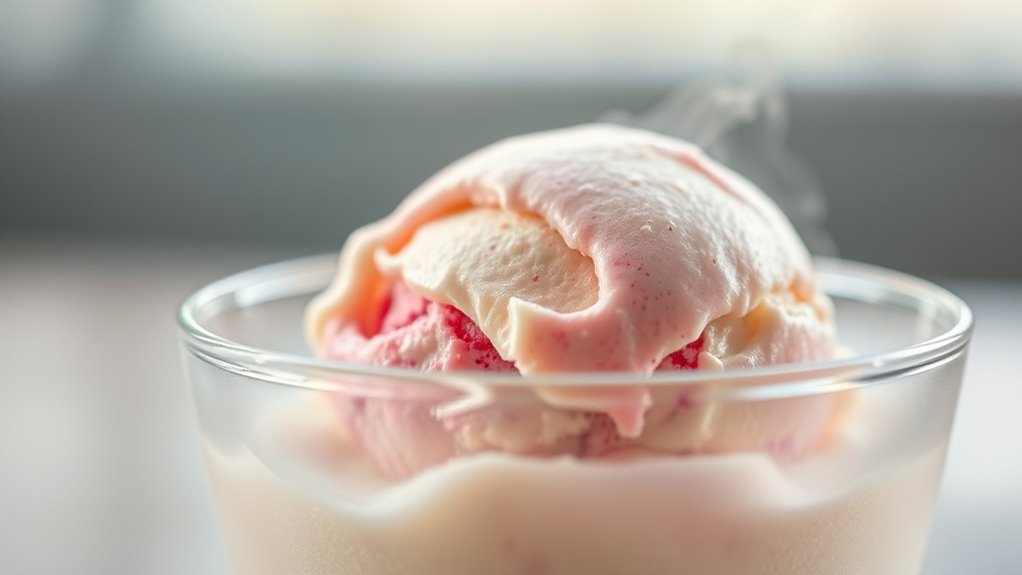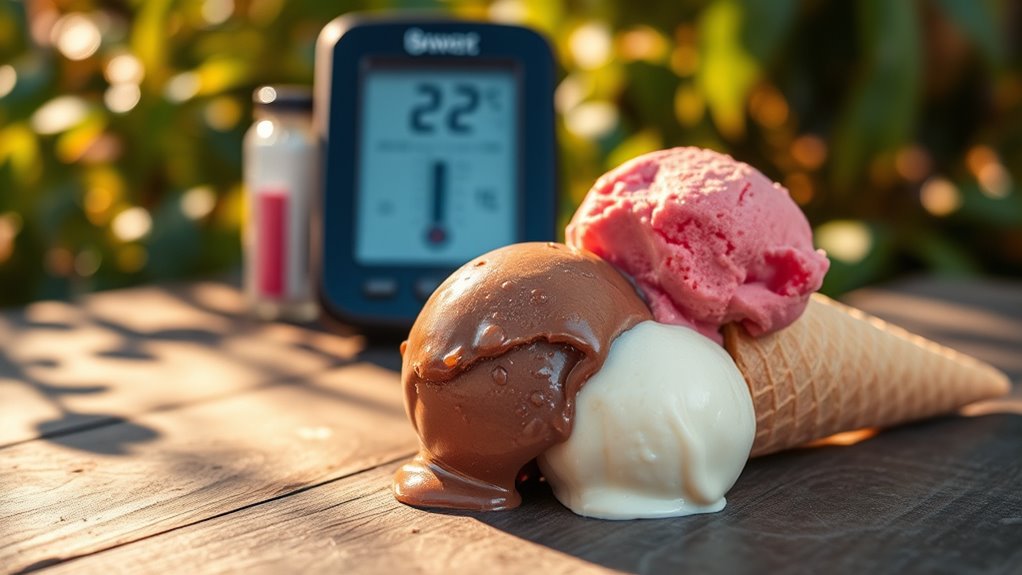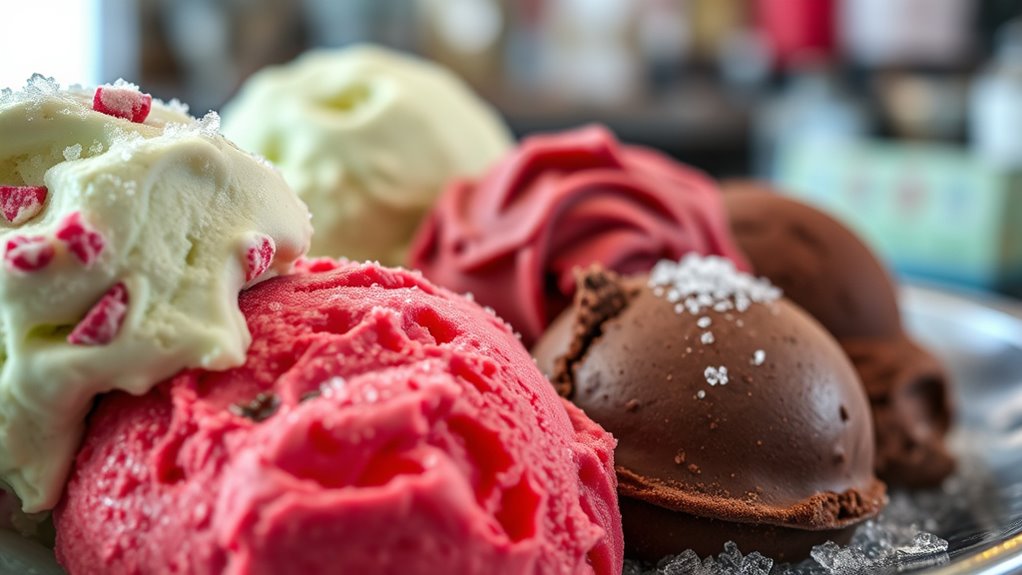The ideal serving temperature for ice cream is between 5°F and 10°F. This range enhances flavor and mouthfeel, ensuring a creamy texture that doesn’t melt too quickly. Factors like fat content and the balance of sugar and air play a key role in achieving the perfect scoop. Keeping your ice cream at this ideal temperature not only elevates your tasting experience but also prevents freezer burn. There’s plenty more to uncover about maintaining the perfect ice cream experience!
Key Takeaways
- The ideal serving temperature for ice cream is between 5°F and 10°F to enhance flavor and mouthfeel.
- Serving ice cream at the proper temperature ensures a balance of firmness and creaminess for optimal tasting experience.
- Slight temperature adjustments can improve aroma release, making the ice cream more flavorful.
- Home freezers should be set between 0°F and 10°F to maintain ideal serving conditions.
- Allow ice cream to temper slightly before serving for easier scooping and better texture.
The Science Behind Ice Cream

When you dig into a scoop of ice cream, you’re not just enjoying a sweet treat; you’re experiencing the intricate science that makes it so delightful.
The ideal serving temperature for ice cream falls between 5 to 10 degrees Fahrenheit. This temperature range enhances both flavor expression and mouthfeel, making your ice cream experience truly memorable.
The perfect serving temperature for ice cream, between 5 to 10 degrees Fahrenheit, enhances flavor and texture for an unforgettable treat.
At proper temperatures, the delicate balance of fat, sugar, air, and water creates a smooth texture while preventing the formation of ice crystals that can ruin quality.
If it’s too cold, ice cream becomes too firm, losing its creaminess. Conversely, warmer temperatures lead to quicker melting and a less enjoyable texture.
Understanding these temperature dynamics helps you appreciate every scoop even more!
Ideal Storage Temperature

To keep your ice cream at its best, aim for an ideal storage temperature of around -18°C (0°F). Maintaining this freezer temperature is vital to avoid issues like freezer burn and to preserve the ice cream’s consistency.
Here are some tips for peak ice cream in storage:
- Always store ice cream at 0°F or lower to prevent texture and flavor degradation.
- Verify the ice cream feels hard to the touch, indicating it’s properly frozen.
- Use specially designated freezers to avoid odor contamination from other foods.
- Keep your freezer temperature consistent to prevent crystallization that can ruin your dessert.
Serving Temperature

When it comes to serving ice cream, hitting the right temperature is essential for the best experience.
You’ll want to keep your ice cream between 5 to 10 degrees Fahrenheit to enjoy its full flavor and creamy texture.
Slight adjustments in temperature can also enhance the aroma, making each bite even more delightful.
Ideal Temperature Range
The ideal serving temperature for ice cream typically falls between 5°F and 10°F, striking the perfect balance between texture and flavor. Serving at this temperature guarantees your ice cream remains creamy and enjoyable.
Here are some key points to remember:
- Optimal Scoopability: Temperatures around 0°F to 6°F make scooping easier while keeping the texture intact.
- Flavor Expression: For gelato, slightly warmer temperatures (10°F to 14°F) enhance aroma release.
- Preserving Integrity: Serving ice cream colder than expected prevents quick melting.
- Maximizing Experience: Proper serving temperatures balance firmness and creaminess for the best mouthfeel.
Flavor Enhancement Techniques
Serving ice cream at the right temperature not only enhances its flavors but also elevates your overall tasting experience. The ideal temperature range is essential, as slightly warmer temperatures allow for better aroma release, which intensifies flavor enhancement.
| Ice Cream Type | Ideal Serving Temperature |
|---|---|
| Premium | 0°F to 6°F |
| Gelato | 10°F to 15°F |
| General Range | 10°F to 14°F |
When serving ice cream cold enough, you maintain a perfect balance of firmness and creaminess. This contributes to an enjoyable texture and helps prevent rapid melting, ensuring you fully appreciate the flavors without overwhelming your palate. Aim for these temperatures to truly savor your ice cream experience!
Factors Affecting Temperature

Understanding the factors that affect ice cream’s temperature can help you enjoy its best qualities. Here are four key elements to take into account:
- Fat Content: Higher fat content allows for a softer texture at lower temperatures, enhancing the creamy mouthfeel.
- Freezing Point: Ingredients like stabilizers and emulsifiers can lower the freezing point, affecting the ideal serving temperature.
- Storage Temperatures: Ice cream with lower fat may need slightly warmer storage to maintain that desirable creamy texture without becoming too hard.
- Sugar and Air: The balance of sugar and air during production influences the perfect serving temperature, enhancing both flavor and mouthfeel.
The Art of Temperature Control

When it comes to serving ice cream, temperature control is an art that can make or break your experience.
You need to set your freezer to the right temperatures and maintain that consistency to guarantee the best quality.
Let’s explore the ideal settings and techniques that keep your ice cream at its delicious best.
Ideal Temperature Settings
To enjoy the full spectrum of flavors and textures ice cream offers, you need to pay attention to its serving temperature.
Here are some key points to take into account:
- The ideal serving temperature for ice cream is between -10°F to -12°F, enhancing flavor and mouthfeel.
- Set your home freezer to 0°F to 10°F for best serving—firm yet scoopable.
- Proper temperature control is essential to maintain ice cream texture and creamy consistency.
- Understanding fat content and storage temperature helps achieve the ideal ice cream experience.
Importance of Consistency
Maintaining the right serving temperature is just one piece of the puzzle; consistency plays an essential role in delivering the perfect ice cream experience.
When ice cream is stored at stable temperatures between -10°F and -20°F, it preserves its ideal texture and flavor. Fluctuations can cause ice crystal formation and freezer burn, ruining the quality.
Consistency in temperature helps maintain the right balance of ice and fat, guaranteeing a creamy mouthfeel. Manufacturers rely on specialized freezers and blast chillers to keep temperatures steady, enhancing your enjoyment.
At home, regularly check your freezer settings to make sure your ice cream stays hard and scoopable without sacrificing its delicious flavor.
Consistent temperature control is crucial for a satisfying treat.
Techniques for Maintaining Quality
Achieving the perfect scoop of ice cream requires careful attention to temperature control throughout its lifecycle. Here are some techniques to maintain quality:
- Store ice cream at or below 0°F: This prevents texture degradation and keeps flavors intact.
- Aim for long-term storage between -10°F and -20°F: This helps avoid ice crystal formation and guarantees a hard consistency.
- Allow ice cream to temper before serving: Bringing it to 5°F to 10°F enhances flavor and makes scooping easier.
- Use specialized scooping tools: These help maintain the ideal serving temperature, assuring a delightful experience.
Tips for Keeping Ice Cream Fresh

Keeping ice cream fresh requires attention to storage conditions, especially since even slight temperature changes can lead to ice crystals and freezer burn.
To maintain quality, store your ice cream container at a consistent temperature of zero degrees Fahrenheit or lower. Insulate your containers with a freezer bag to minimize temperature fluctuations when you open the freezer door.
When shopping, select ice cream stored below the freezer line to guarantee it’s been kept cold enough. Always place your ice cream in the main part of the freezer instead of the door, where temperatures vary more.
Before sealing, cover the surface with plastic wrap to limit exposure to air, which helps preserve freshness and prevent freezer burn.
Enjoy your delicious ice cream!
Frequently Asked Questions
What Temperature Should Ice Cream Be Served At?
When it comes to enjoying your favorite frozen treat, the temperature you serve it at really matters.
You want it to be cool enough to maintain that delightful firmness, yet warm enough to enhance the flavors. Generally, aim for a range that allows the flavors to shine through without losing that creamy texture.
Finding the sweet spot can elevate your ice cream experience, making each bite a delicious moment to savor. Enjoy responsibly!
What Temperature Should You Eat Ice Cream At?
When you eat ice cream, you’ll want it at the right temperature for the best experience. Aim for around 10°F to 14°F to enjoy its creamy texture and rich flavors.
If you’re savoring premium varieties, keep them between 0°F and 6°F, while gelato shines at 10°F to 15°F.
Soft serve is best enjoyed at 18°F to 22°F, giving you that smooth mouthfeel.
Enjoy your treat at these temps for maximum delight!
What Temperature Should Ice Cream Be to Scoop?
Did you know that ice cream’s ideal scooping temperature is typically around 6 to 10 degrees Fahrenheit?
At this range, you’ll find that the ice cream’s texture is just right, allowing for easy scooping without losing its creaminess. If it’s colder, it becomes rock hard, making it tough to serve.
To enhance your experience, consider using warmed scooping tools or briefly microwaving the pint for that perfect balance between firmness and ease.
Will Ice Cream Stay Frozen at 40 Degrees?
No, ice cream won’t stay frozen at 40 degrees. At this temperature, it starts to melt and can lose its creamy texture.
You might notice ice crystals forming if it partially melts and then refreezes. Plus, prolonged exposure to temperatures above 32 degrees can lead to freezer burn and flavor loss.
To keep your ice cream at its best, you should store it at temperatures below 10 degrees.
Conclusion
So, next time you scoop out that delicious ice cream, remember that serving it at the right temperature makes all the difference. You might think it’s fine to serve it straight from the freezer, but that’ll leave it hard and less enjoyable. Give it a few minutes to soften up, and you’ll reveal the rich flavors and creamy texture you love. Trust me, it’s worth the wait for the perfect scoop!










